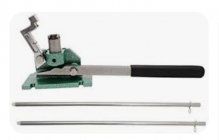I used a Lee Autoprime when I started loading in the mid-80's until a few years ago when it became too worn and I ran out of spare parts. It was finally time to move on. I considered buying a Frankford Arsenal, which is apparently the modern replacement of the old Lee and almost certainly made of better materials.
I used to hand prime everything. However, I now load most handgun rounds on either a progressive or turret press. Except for smaller batches of other handgun rounds, I only manually prime for rifle, which I shoot in much less volume. As I've a read more accounts over the years of primer mishaps including a few with the Claymore mine style primer reservoirs like the old Lee design, I'm less keen on using them. The chances of ever having a problem are very low, but with my luck...
A friend has a 21st Century priming tool, and it's very nicely made. I didn't want to spend that much on a new hand primer and also have to buy new shell holders for it. I already had the Lee Autoprime shell holders, which the K&M tool uses (so does the Frankford), so I bought a basic K&M. It took some getting used to, but priming one at a time isn't so bad. The K&M isn't as nicely finished as the 21st Century, but it's solid and should last a long time.
The OP mentioned "adjustable, precision seating." As for priming precision, I think how to do it best is debatable and depends on the circumstances. Feel vs fixed seating ram depth. Which is better? IMO, it depends. Watch Eric Cortina's interview with Greg from Primal Rights:
Longer version here:
Some good points are made in that interview. Notable is the tight consistency of dimensions of factory (not-uniformed) primer pocket depths to the undersides of case rims in high quality brass (Lapua). In that situation, assuming the primer cups themselves are also of tight tolerance, seating to a fixed depth makes sense. You'd get fairly consistent crush.
K&M has their fancier, complicated tool that measures primer pocket depth, primer height, and then allows you to set to a given amount of crush. I've never used one and won't because such minor differences in primer seating would make no noticeable difference in what I'm doing. However, this is the only setup I've seen that allows one to set primer crush the same on each case even if the primer pockets aren't all exactly the same.
My situation is different than precision shooters using the best quality brass. For .223 I'm using Wolf Gold brass, which is generally good quality in the scheme of things (I'd say on par with or better than Lake City), but certainly nowhere near Lapua in consistency. I can't depend on the distance from the inside of the case rims to the bottoms of the primer pockets being consistent when new. I uniform the primer pockets to prevent having some high primers.
Uniforming sets primer pocket depths consistent with the outside of the case heads, while seating primers with a fixed ram depth seats primers to a point indexed from the inside of the case rims. The difference between the relationship of the inside of the case rim to primer pocket bottom and outside of the case head to primer pocket bottom can be quite different as explained in that interview. In addition, my rims have some minor dings from being extracted from a semi-auto, which could change the relationship of the case within the shell holder.
In my situation I'm better off seating primers by feel to the bottom of the pockets instead of using a priming tool with a fixed ram depth. I don't doubt that primer crush consistency matters when you're eeking out the best precision possible (benchrest, long range precision, etc.). But I think how to attain consistent primer seating varies depending on what components you're using and what you are doing with them. A fixed depth primer seater won't help me, whether it costs $100 or $600. If anything, switching to a fixed primer seating depth while having varying depth primer pockets could make things noticeably worse than seating by feel if the pocket to inside rim dimensions vary enough to cause some primers to not even be contacting the bottom of the pocket.
















